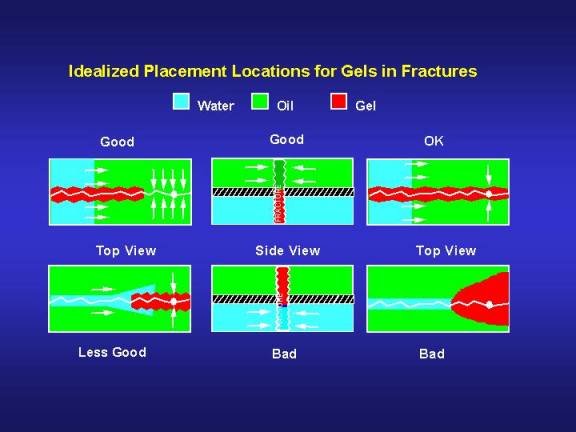Is Gel Placement Important in Wells or Reservoirs with Fractures?
(Yes.)
Calculations using the Darcy equation reveal that an acceptable gel placement is much easier to achieve in linear flow (e.g., wells with fractures) than in radial flow (e.g., wells without fractures). However, this fact does not mean that gel placement is unimportant in fractured wells. Fig. 4 shows idealized placement locations for gels in fractures. First, consider a production well where water channels through a fracture. In the ideal gel placement, the fracture is plugged far from the wellbore, but the fracture remains open near the well (upper left part of Fig. 4). Then, water channeling can be reduced while maintaining a high productivity for the well. If the gel plugs the near-wellbore portion of the fracture (lower left part of Fig. 4), water channeling may be reduced, but the productivity of the well could be lowered to an unacceptable value.
In vertical fractures that cut through multiple zones, we might want to exploit gravity and density differences to place gel in the lower part of a fracture, thereby reducing water influx from the lower zones while leaving the upper part of the fracture open to oil flow (center part of Fig. 4). In contrast, gel placement in the upper part of the fracture could be detrimental.
The amount of gelant that leaks off from a fracture face is also important (right side of Fig. 4). Ideally, the distance of gelant leakoff from the fracture face should be very small. If the leakoff distance is too great, the near-wellbore region could be plugged, and the gel treatment could do more harm than good. A basic principle of fluid displacement in porous media is that the efficiency of the displacement increases with increasing viscosity of the injected fluid.1,3This principle suggests that other factors being equal in a fractured system, the distance of gelant leakoff will be greater for a high-viscosity gelant than for a low-viscosity gelant. For gel treatments, this principle presents a potential problem for viscous gelants—that too much gelant may leak off from the fracture into the formation rock. Leakoff associated with the use of viscous gelants could compromise the effectiveness of a treatment unless it is controlled.

Thus, gel placement is extremely important in fractured wells and reservoirs. This topic is one of our major research areas. It will be discussed in more detail in our next report. Our previous work in this area is described in Refs. 16 and 17.